When a society is undergoing rapid change—economic and technological change, religious change, language change, social change—and particularly when that change is being imposed on them by outside forces, it is not uncommon for a prophet to emerge. This prophet will report having had a mystical experience which often involved a visit with powerful spirits who provided instructions which were to be taken back to the people. These instructions, the prophet tells the people, provide a way of coping with the new changes. In the first decades of the nineteenth century, the Kickapoo were facing the consequences of the European invasions into their territories in the Great Lakes region. With superior firepower and numbers, American settlers were taking their lands, burning their villages, and demanding that they move. At the same time Christian missionaries were telling them that their old spiritual ways were evil and that they had to submit to the Christian god or be exterminated.
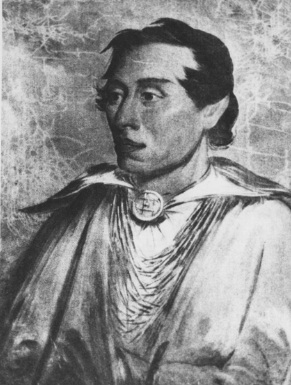
About 1815, the Kickapoo leader and warrior Kennekuk (also spelled Kenakuk, Kaanakuk, Kannekuk, Kenekuk) had a vision in which the Great Spirit spoke to him. He begins to preach a message of pacificism and accommodation for the Americans. His new religious doctrine borrowed many elements from Christianity. The new spiritual path was opposed to alcohol, polygyny, and warfare. In their entry on the Kickapoo in the Handbook of North American Indians, Charles Callender, Richard Pope, and Susan Pope report:
“Ostracized by the rest of the Kickapoo, Kenekuk and his followers were favored by government officials who approved of their attitudes.”
Kennekuk and about 250 of his followers established their own village.
The Kickapoo
The designation Kickapoo comes from Kiwegapaw meaning “he moves about, standing now here, now there,” which was their aboriginal name. With regard to language, Kickapoo is classified as a Central Algonquian language along with Miami, Illinois, Shawnee, Sauk, Fox, Menominee, Potawatomi, Ojibwa, Cree, Montegnais, and Naskapi.
There was no overall Kickapoo tribal government: each of the bands was autonomous with its own leader as well as war chiefs and warriors. Kickapoo subsistence was based on a combination of farming (maize, beans, squash), gathering wild plant foods, and hunting.
Kickapoo ceremonialism was centered around clan bundles—animal skin pouches containing sacred objects. The clans were patrilineal, meaning that people belonged to their father’s clan. Some people had a special ability to communicate with the spirit world and could thus predict the future and cure the sick.
Europeans, in the form of the French Jesuit Claude Jean Allouez, first made contact with the Kickapoo in the mid-1600s. At that time, they were living in what is now Wisconsin. Oral traditions indicate that prior to this they had lived to the east in what is now Michigan. A century or so later, the Kickapoo were living in what is now Illinois.
By 1812, the Americans were actively warring against the Kickapoo. Soon there is an army of 2,000 soldiers pursuing the Kickapoo warriors. Soon the army found itself under attack by 150 Kickapoo warriors, divided into small bands, who waged a campaign of harassment against them.
In 1814, the United States was able to force a peace treaty on many of the tribes in the area, including the Kickapoo. The United States, however, wanted more than just peace with the Indians: the United States wanted Indian land and the removal of all Indians from Illinois.
In 1819, treaties were negotiated with the two Kickapoo bands. In his book The Kickapoos: Lords of the Middle Border, A.M. Gibson reports:
“After months of lengthy councils, during which tons of government provisions were used to feed the tribe and headmen, the commissioners won their treaties.”
The treaties promised the Kickapoo and their heirs a reservation forever in Missouri in exchange for their lands in Illinois. A.M. Gibson reports:
“The removal of the Kickapoos from Illinois and Indiana to the Osage River was a part of a broad national policy to evacuate a number of tribes to the area beyond the trans-Mississippi settlement.”
When the Kickapoo arrived at their new lands in Missouri, they found that the government had already surveyed a site for their reservation. They had been promised that they could choose their own land. The Kickapoo leaders charged that the American treaty negotiators had cheated them out of their Illinois lands.
The Missouri lands which the United States had promised to the Kickapoo were actually occupied by the Osage. The Kickapoo and the Osage were traditional enemies.
What became the Kickapoo resistance involved two bands which opposed removal. Mecina’s band was active in its resistance, often destroying the property of the American invaders. Kennekuk’s band turned to passive resistance.
Kennekuk
Kennekuk’s Kickapoo band lived along the Osage River in Illinois. It is generally believed that he had been born about 1785 (some sources indicate 1790), but little is known about his early life, about the time before he became a band leader.
According to some accounts, as a young man, Kennekuk (Putting His Foot Down) had a reputation for violence and for being a drunkard like his father. Once, in a drunken rage, he killed his uncle and was banished from the tribe. During his banishment, Kennekuk learned some of the fundamentals of Christianity and when he returned to the Kickapoo he married and became a leader.
In 1810, many Kickapoos visited Prophetstown, Indiana to hear the words of Tenskatawa, the Shawnee prophet. Kennekuk may have been among them and Tenskatawa’s teachings seem to have influenced Kennekuck’s spiritual path.
Following his vision in about 1815, Kennekuk emphasized to his band the need to avoid alcohol. He also advocated that individuals use meditation, fasting, and wooden prayer sticks to help bring about a new world in which there would be an abundance of food and a lack of enemies.
By 1819, the Kennekuk had refined his message of peace and used a sacred chart which showed the path through fire and water to heaven. He told his followers to remain where they were, to avoid quarrels among themselves, whiskey, and breaking non-Indian laws. His followers carried a wooden prayer stick engraved with mystic symbols. In their book Native American Almanac: More than 50,000 Years of the Cultures and Histories of Indigenous Peoples, Yvonne Dennis, Arlene Hirschfelder, and Shannon Flynn write:
“He worked to create a new moral and religious community for his followers, one that drew on elements of Catholic and Protestant faith as well as traditional Kickapoo beliefs.”
Kennekuk’s new religious message was not confined to the Kickapoo, but also reached other Algonquian-speaking peoples in the Great Lakes area. In 1820, about 70 Potawatomi followers moved to his village in order to be closer to him.
In the 1820s, American pressure for the Kickapoo to be removed from Illinois increased and Kennekuk responded with a strategy of passive resistance. In his book Who Was Who in Native American History, Carl Waldman reports:
“Meeting frequently with white officials, especially William Clark in St. Louis, Kennekuk managed to stall by expressing a willingness to depart westward, while at the same time offering excuses for delays—the harvest, illness, or evil omens.”
In 1826, William Clark met with the Kickapoo in an attempt to get them to exchange their lands on the Osage River for new lands on the Missouri River in Kansas. Clark promised them that the Americans would break the ground for them, help them build fences and divide their land into individually owned parcels, build permanent houses for them, and provide them with seed, fruit trees, cattle, and chickens.
In 1827, Kennekuk told William Clark that the Great Spirit had again appeared to him. At St. Louis, he told Clark:
“My father, the Great Spirit has placed us all on this earth; he has given to our nation a piece of land. Why do you want to take it away and give us so much trouble?”
Finally, in 1832, Kennekuk was forced to sign the Treaty of Castor Hill in which he agreed to exchange his band’s land for land along the Missouri River in Kansas. Although he attempted to delay the move, in 1833, Kennekuk and 350 of his followers moved to Kansas.
In Kansas, Kennekuk continued to preach his religion and to negotiate with the Americans on behalf of his people. In his entry on the Kickapoo in the Encyclopedia of North American Indians, Joseph Herring writes:
“A central tenet of the religion was a strict edict against relinquishing lands to whites. Ordering adherents to put aside their clan bundles, to abstain from alcohol and other vices, and to live peacefully with whites, Kenekuk helped them adjust to a rapidly changing, white-dominated world and withstand efforts to expel them from Kansas.”
In 1852, he died of smallpox. Before dying, he promised that he would come back in three days. There is no indication that he actually came back. Thanks to the efforts of Kennekuk, there are still Kickapoos in Kansas and some of them still follow his religion.
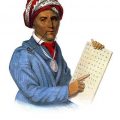
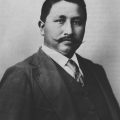
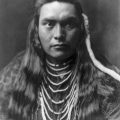
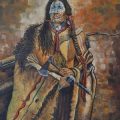
Leave a Reply